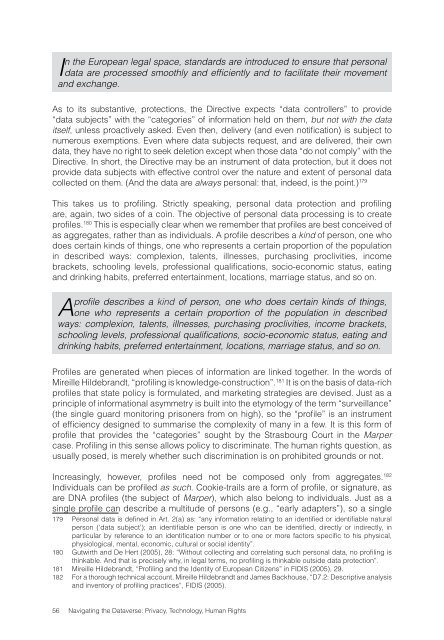Navigating the Dataverse: Privacy, Technology ... - The ICHRP
Navigating the Dataverse: Privacy, Technology ... - The ICHRP
Navigating the Dataverse: Privacy, Technology ... - The ICHRP
Create successful ePaper yourself
Turn your PDF publications into a flip-book with our unique Google optimized e-Paper software.
In <strong>the</strong> European legal space, standards are introduced to ensure that personal<br />
data are processed smoothly and efficiently and to facilitate <strong>the</strong>ir movement<br />
and exchange.<br />
As to its substantive, protections, <strong>the</strong> Directive expects “data controllers” to provide<br />
“data subjects” with <strong>the</strong> “categories” of information held on <strong>the</strong>m, but not with <strong>the</strong> data<br />
itself, unless proactively asked. Even <strong>the</strong>n, delivery (and even notification) is subject to<br />
numerous exemptions. Even where data subjects request, and are delivered, <strong>the</strong>ir own<br />
data, <strong>the</strong>y have no right to seek deletion except when those data “do not comply” with <strong>the</strong><br />
Directive. In short, <strong>the</strong> Directive may be an instrument of data protection, but it does not<br />
provide data subjects with effective control over <strong>the</strong> nature and extent of personal data<br />
collected on <strong>the</strong>m. (And <strong>the</strong> data are always personal: that, indeed, is <strong>the</strong> point.) 179<br />
This takes us to profiling. Strictly speaking, personal data protection and profiling<br />
are, again, two sides of a coin. <strong>The</strong> objective of personal data processing is to create<br />
profiles. 180 This is especially clear when we remember that profiles are best conceived of<br />
as aggregates, ra<strong>the</strong>r than as individuals. A profile describes a kind of person, one who<br />
does certain kinds of things, one who represents a certain proportion of <strong>the</strong> population<br />
in described ways: complexion, talents, illnesses, purchasing proclivities, income<br />
brackets, schooling levels, professional qualifications, socio-economic status, eating<br />
and drinking habits, preferred entertainment, locations, marriage status, and so on.<br />
profile describes a kind of person, one who does certain kinds of things,<br />
A one who represents a certain proportion of <strong>the</strong> population in described<br />
ways: complexion, talents, illnesses, purchasing proclivities, income brackets,<br />
schooling levels, professional qualifications, socio-economic status, eating and<br />
drinking habits, preferred entertainment, locations, marriage status, and so on.<br />
Profiles are generated when pieces of information are linked toge<strong>the</strong>r. In <strong>the</strong> words of<br />
Mireille Hildebrandt, “profiling is knowledge-construction”. 181 It is on <strong>the</strong> basis of data-rich<br />
profiles that state policy is formulated, and marketing strategies are devised. Just as a<br />
principle of informational asymmetry is built into <strong>the</strong> etymology of <strong>the</strong> term “surveillance”<br />
(<strong>the</strong> single guard monitoring prisoners from on high), so <strong>the</strong> “profile” is an instrument<br />
of efficiency designed to summarise <strong>the</strong> complexity of many in a few. It is this form of<br />
profile that provides <strong>the</strong> “categories” sought by <strong>the</strong> Strasbourg Court in <strong>the</strong> Marper<br />
case. Profiling in this sense allows policy to discriminate. <strong>The</strong> human rights question, as<br />
usually posed, is merely whe<strong>the</strong>r such discrimination is on prohibited grounds or not.<br />
Increasingly, however, profiles need not be composed only from aggregates. 182<br />
Individuals can be profiled as such. Cookie-trails are a form of profile, or signature, as<br />
are DNA profiles (<strong>the</strong> subject of Marper), which also belong to individuals. Just as a<br />
single profile can describe a multitude of persons (e.g., “early adapters”), so a single<br />
179 Personal data is defined in Art. 2(a) as: “any information relating to an identified or identifiable natural<br />
person (‘data subject’); an identifiable person is one who can be identified, directly or indirectly, in<br />
particular by reference to an identification number or to one or more factors specific to his physical,<br />
physiological, mental, economic, cultural or social identity”.<br />
180 Gutwirth and De Hert (2005), 28: “Without collecting and correlating such personal data, no profiling is<br />
thinkable. And that is precisely why, in legal terms, no profiling is thinkable outside data protection”.<br />
181 Mireille Hildebrandt, “Profiling and <strong>the</strong> Identity of European Citizens” in FIDIS (2005), 29.<br />
182 For a thorough technical account, Mireille Hildebrandt and James Backhouse, “D7.2: Descriptive analysis<br />
and inventory of profiling practices”, FIDIS (2005).<br />
56 <strong>Navigating</strong> <strong>the</strong> <strong>Dataverse</strong>: <strong>Privacy</strong>, <strong>Technology</strong>, Human Rights
















